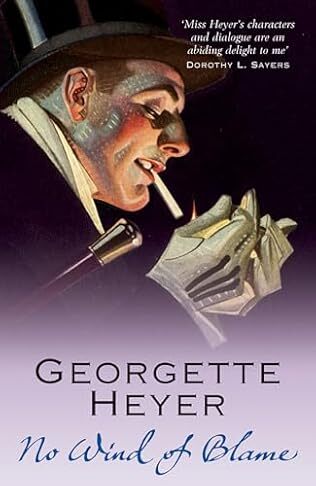No Wind Of Blame

A review of No Wind of Blame by Georgette Heyer – 250809
The first in Heyer’s Inspector Hemingway series and originally published in 1939, No Wind of Blame mixes a murder mystery which like a Victorian novel hinges on an abstruse legal point and an ingenious method of pulling off the crime with some really delightful and memorable characters. Poor Inspector Hemingway has his work cut out when he enters the portals of Ermyntrude Carter’s domain.
Walter, Ermyntrude’s husband, is a poor catch, a spendthrift, always short of money but buoyed by the prospect of a large inheritance from a semi-mythical dotty aunt, Clara, who is locked away in a mental institution. He is alleged to have put a young woman from the area in the family way and makes out that he needs £500 to pay off the family. On his way to a meeting with a couple of other old reprobates, Wally is shot dead in plain sight. Vicky, Ermyntrude’s daughter, is near the scene but saw nothing suspicious and, tellingly, her dog did not bark.
When he investigates the site, Hemingway finds a hairpin, a magnet, and some strange markings around the base of a tree. Eventually, when he sees his way through the distractions and red herrings, he is able to reconstruct the method by which the gun was fired, allowing to break a seemingly cast-iron alibi and bring the culprit to justice.
The motive for the murder is the destination of Aunt Clara’s estate which, if she died before Carter, would go to his cousin, the sensible, level-headed Mary, but if Carter were to die first, the legacy would be subject to the laws of intestacy. Once it is clear what would happen in those circumstances, the motivation for the murder is clear as is the murderer’s identity. That said, frankly, it is difficult for the reader to second guess that until it emerges deus ex machina-like towards the end of the tale.
If the reader cannot really play sleuth, there is more than enough to enjoy. Heyer has populated her novel with some wonderful and memorable characters and there are many moments of humour. Ermyntrude herself is a larger than life figure, a former actress, highly strung, anxious to make her way in county society but she is topped by the marvellous comic creation that is Vicky. She assumes various roles and characters, playing them with gusto, and really does not care what people think of her, least of all Hemingway, or what the consequences are of her behaviour.
Vicky has a particular down on the latest house guest, the exotic Georgian Prince Varasashvili, who has set his sights on winning Ermyntrude’s hand and, as a foreigner, is an immediate suspect for her husband’s murder. The scene in which she foils the Prince’s plans and makes her mother see him for what he is is the highlight of the book and I shall chuckle over it for some time. We know that the Prince will be a figure of fun as soon as Heyer chooses Prince as the name of the Carter’s dog,
It would not be a Heyer without some romance in the air. As well as Vicky getting her man, a rather suitable catch which is in accord with Ermyntrude’s desire to establish the family into society, but the sensible Mary also finds her man in the local doctor, Maurice Chester. Two marriages and a culprit apprehended, what more do you want?
Hemingway is an engaging and determined sleuth, never quite put off his stride by the characters he encounters and clever enough to reconstruct the methodology of the crime. There is much to admire in this story.



